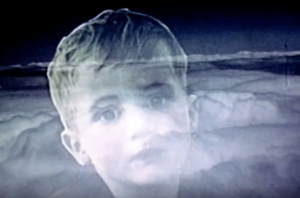
"Dear Little Lightbird was entered as an experimental film by Leland Auslender, who also won one of the four top awards in the Class C category. He has a way with color, light and angles, and this talent easily put his film in the Top Ten. It's a story of a little boy born with an incurable disease, and how his three years of life brought into focus all the wonders of nature and this world around us. Perhaps this 18-minute film could be shortened somewhat, but it doesn't seem to matter for the film surrounds you with unusual shots of the simple things most of us miss in the helter-skelter of everyday life" PSA Journal, Oct. 1968, 49.
"Give Her My Love is a film in black-and-white made by a student of cinematography. It is a story of young love and the strange turn that young love can take. Jeff Blyth's handling of the story made the film a strong contender for the Scenario Award. A shy boy's life in an office and his second-hand love for a girl are well portrayed as a triangle develops and then becomes a zero" PSA Journal, Oct. 1968, 49.
"Jeanette from Scotland won the Scenario Award for a story with a very touching twist at the end. Not much can be written as to its content without giving away the story and thus spoiling it for you when you see it. Rex Palmer did this one in black-and-white (only two other films in the Ten Best were not in color), with a deft handling of the story that tends to mislead you right up to the very end. It easily won as Best Foreign Film in this year's competition" PSA Journal, Oct. 1968, 48.
"The Legend of San San Ku was a practically unanimous choice as winner of the top award with its story of a Japanese legend. If the credits were to be removed from the beginning of this film, it would be hard to believe that it was not made in Japan. It was a very ambitious production for a crew of amateurs to undertake, and they came through with flying colors. Here's 20 minutes of Japan that is delightful to experience" PSA Journal, Oct. 1968, 48.
"Numerical Order is a learning-how-to-count film. Through some very beautiful art work, paste-up, and other production techniques, Bill Peterson shows how to count. He has found a reason for every number up to 100. Your better judgement tells you he couldn't possibly keep up his starting pace until reaching 100, but he does except for one little bit of cheating. A film like this must have taken a million hours of patience to produce in addition to a lot of talent" PSA Journal, Oct. 1968, 48.
"On the Reef can refer to only one place in the world and that's the Great Barrier Reef off the eastern coast of Australia. Graemer Grosvenor handled the world of sea life very nicely with a smooth flowing story of a group of young adventurers in this area of the unusual. This film from Australia had no difficulty in capturing the Nature Film Award" PSA Journal, Oct. 1968, 49.
A documentary film of sand and its use in two of the most important elements that constantly surround the life of man: glass and concrete.
Total Pages: 299